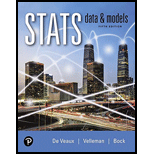
Concept explainers
Explain the reason for the study to be an observational study.
Check whether it is possible to conclude that steroids caused an increase in homeruns.
Answer to Problem 1E
The given study is a retrospective observational study.
No, it is not possible to conclude that the steroids caused an increase in homeruns.
Explanation of Solution
Given info:
A researcher’s wish is to examine the effect of steroids in major league baseball; in general, it is known that most of the players take steroids to increase the performance in the field. For this, the sports writer compares the homeruns and steroids intake from the 1960’s.
Justification:
Observational study:
An observational study measures the values of a variable without influencing the values of response variables and explanatory variables. Thus, in an observational study, researchers can observe the behaviors of the individuals without influencing the outcome of that study.
Here, the researcher ask the individual players whether they take steroids or not and observes their homerun totals. The researchers do not influence the individuals to take steroids but merely observe.
Hence, this is an observational study.
Here, there is a relationship between steroids and homerun totals.
Causation:
If one
Even though there is an association between the variables “steroids” and “homerun totals”, the association between the two variables does not infer that the change in one variable is the cause of the change in other variables.
Moreover, the most important thing is that
Lurking variable:
The lurking variable is a type of extraneous variable which is not accounted for under the study. However, it may affect response variables or explanatory variables.
There is a chance for the variables “steroids” and “homerun totals” to not have direct association. The association exists through the lurking variable.
In general case, there is a possibility for the existence of a lurking variable which will be associated with both the variables “steroids” and “homerun totals”.
Therefore, the steroids do not cause homeruns.
Thus, there is no causation between the variables “steroids” and “homerun totals”.
Want to see more full solutions like this?
Chapter 11 Solutions
Stats: Data and Models
- Should you be confident in applying your regression equation to estimate the heart rate of a python at 35°C? Why or why not?arrow_forwardGiven your fitted regression line, what would be the residual for snake #5 (10 C)?arrow_forwardCalculate the 95% confidence interval around your estimate of r using Fisher’s z-transformation. In your final answer, make sure to back-transform to the original units.arrow_forward
- BUSINESS DISCUSSarrow_forwardA researcher wishes to estimate, with 90% confidence, the population proportion of adults who support labeling legislation for genetically modified organisms (GMOs). Her estimate must be accurate within 4% of the true proportion. (a) No preliminary estimate is available. Find the minimum sample size needed. (b) Find the minimum sample size needed, using a prior study that found that 65% of the respondents said they support labeling legislation for GMOs. (c) Compare the results from parts (a) and (b). ... (a) What is the minimum sample size needed assuming that no prior information is available? n = (Round up to the nearest whole number as needed.)arrow_forwardThe table available below shows the costs per mile (in cents) for a sample of automobiles. At a = 0.05, can you conclude that at least one mean cost per mile is different from the others? Click on the icon to view the data table. Let Hss, HMS, HLS, Hsuv and Hмy represent the mean costs per mile for small sedans, medium sedans, large sedans, SUV 4WDs, and minivans respectively. What are the hypotheses for this test? OA. Ho: Not all the means are equal. Ha Hss HMS HLS HSUV HMV B. Ho Hss HMS HLS HSUV = μMV Ha: Hss *HMS *HLS*HSUV * HMV C. Ho Hss HMS HLS HSUV =μMV = = H: Not all the means are equal. D. Ho Hss HMS HLS HSUV HMV Ha Hss HMS HLS =HSUV = HMVarrow_forward
 MATLAB: An Introduction with ApplicationsStatisticsISBN:9781119256830Author:Amos GilatPublisher:John Wiley & Sons Inc
MATLAB: An Introduction with ApplicationsStatisticsISBN:9781119256830Author:Amos GilatPublisher:John Wiley & Sons Inc Probability and Statistics for Engineering and th...StatisticsISBN:9781305251809Author:Jay L. DevorePublisher:Cengage Learning
Probability and Statistics for Engineering and th...StatisticsISBN:9781305251809Author:Jay L. DevorePublisher:Cengage Learning Statistics for The Behavioral Sciences (MindTap C...StatisticsISBN:9781305504912Author:Frederick J Gravetter, Larry B. WallnauPublisher:Cengage Learning
Statistics for The Behavioral Sciences (MindTap C...StatisticsISBN:9781305504912Author:Frederick J Gravetter, Larry B. WallnauPublisher:Cengage Learning Elementary Statistics: Picturing the World (7th E...StatisticsISBN:9780134683416Author:Ron Larson, Betsy FarberPublisher:PEARSON
Elementary Statistics: Picturing the World (7th E...StatisticsISBN:9780134683416Author:Ron Larson, Betsy FarberPublisher:PEARSON The Basic Practice of StatisticsStatisticsISBN:9781319042578Author:David S. Moore, William I. Notz, Michael A. FlignerPublisher:W. H. Freeman
The Basic Practice of StatisticsStatisticsISBN:9781319042578Author:David S. Moore, William I. Notz, Michael A. FlignerPublisher:W. H. Freeman Introduction to the Practice of StatisticsStatisticsISBN:9781319013387Author:David S. Moore, George P. McCabe, Bruce A. CraigPublisher:W. H. Freeman
Introduction to the Practice of StatisticsStatisticsISBN:9781319013387Author:David S. Moore, George P. McCabe, Bruce A. CraigPublisher:W. H. Freeman





